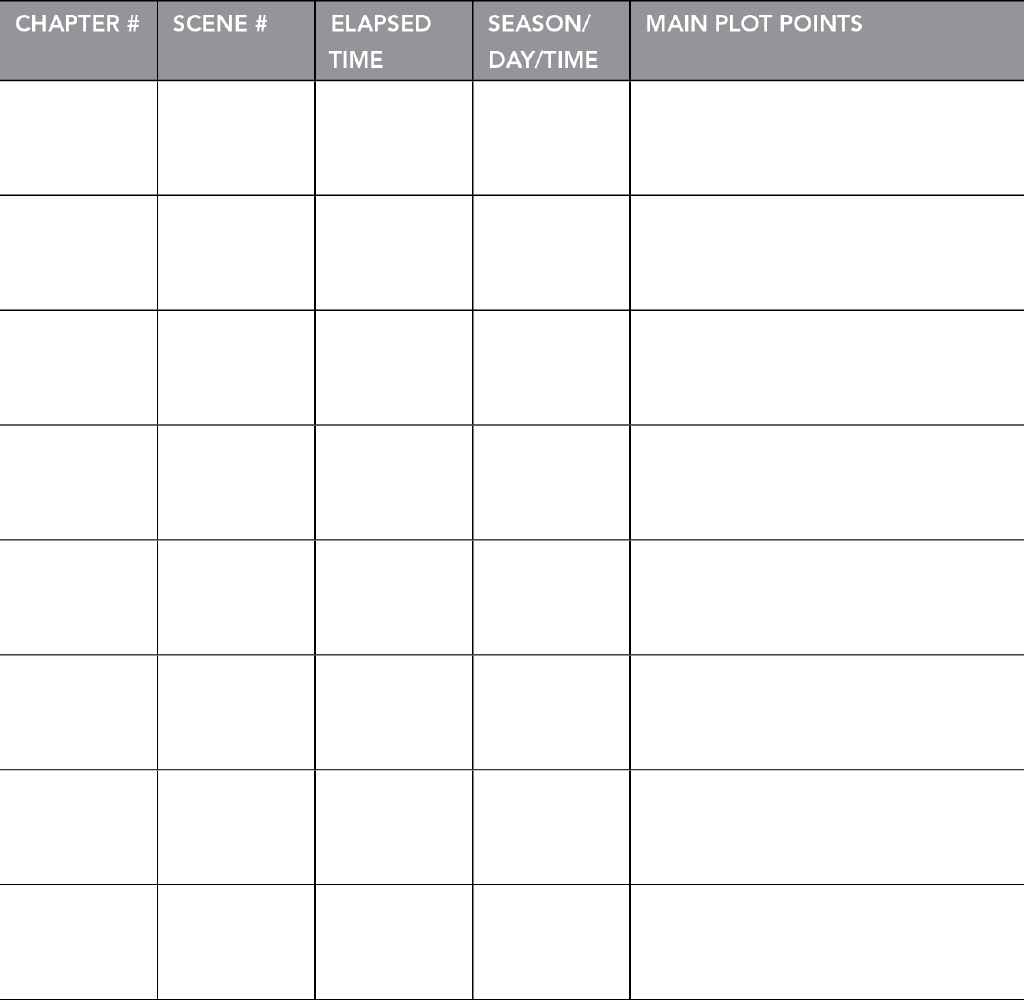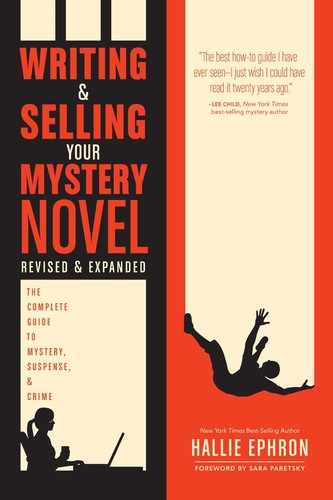Chapter 25
Flying High
Fixing Plot and Character
“My pencils outlast their erasers.”
—Vladimir Nabokov
It’s tempting to open up your document and start editing, tweaking word choices and punching up sentences. Sure, you could do that, or you could take a more strategic approach and look first at the big picture. That’s not an easy task when we’re talking about a 260- to 400-page manuscript.
This chapter suggests ways to fly high over your manuscript, focusing on the big fixes needed. After that, read through subsections, focusing on specific aspects that need pulled apart and addressed.
I recommend three techniques for this process:
- Reread from start to finish, examining the main plot and central character; list the changes you need to think about making.
- Create a scene-by-scene outline, and analyze the chronology and pacing.
- Take multiple selective read-throughs, leapfrogging through your manuscript so you can isolate and examine subplots and characters.
REREADING FROM START TO FINISH: EXAMINING THE MAIN PLOT AND MAIN CHARACTER
After you’ve let your manuscript cool for a few weeks, reread it from start to finish. During the read-through, take notes and keep a running list of suggestions for changes. Pay special attention to these aspects of your novel:
- The main plot
- Does your plot unfold logically and believably, without resorting to coincidence? Would these characters do what your novel has them do?
- Are there at least three major plot twists (turning points where attention is diverted to an innocent suspect or where the murder seems to be something that it isn’t)?
- Have you planted all the clues in the story so the solution is plausible?
- Have you camouflaged the clues well and distracted the reader’s attention with red herrings so the ending is a surprise?
- Have you played fair with the reader and shared what your point-of-view character knows?
- By the final page, have you explained whodunit, why, and how, and tied up all the loose ends?
- Point of view
- Whether you’ve chosen to write in the first person or third, from single or multiple points of view, have you adhered consistently to your choices?
- Can you strengthen each narrator’s voice and make it more consistent throughout the novel?
- The main character
- Have you adequately established why this particular protagonist needs to solve this particular crime without resorting to a backstory dump in the first act?
- Have you given your character a sufficiently rich inner life so the reader knows both how she behaves and also what she thinks?
- Are your character’s dialogue, inner dialogue, and behavior throughout the book consistent with his personality?
- Does your character actively do the detecting to solve the mystery?
- Have you raised the stakes for the protagonist as the story moves forward?
- Are all the heroics your character undertakes consistent with who she is?
- Near the end, does your character hit the wall? Is he out of options, feeling despair, or certain that there’s no way out?
- Is there a satisfying confrontation in which the protagonist defeats the villain?
- By the end, have you resolved your character’s inner journey as well as solved the mystery?
- The villain
- Have you established a convincing reason why the villain committed the crime(s)?
- Have you given the villain a sufficiently major role in the novel so that the reader has a shot at guessing his identity?
- Did you make the villain seem innocent through most of the novel so the revelation of guilt comes as a surprise?
- Did you lay the groundwork for guilt so the revelation seems plausible?
CREATING A SCENE OUTLINE
A scene outline is a useful tool for looking at the big picture. While I’m rereading my manuscript, I put together this outline. For each scene, my outline contains these elements:
- the basic chronology, including when the scene takes place and how much time has elapsed since the start of the novel
- a brief overview of what happens in the scene
- the payoff: what this scene contributes to the plot
Keep your scene outline spare. If you include too much detail, you defeat the purpose of this tool, which is to give you a bird’s-eye view of your novel. The example below is the beginning of a scene-by-scene outline for my novel Never Tell a Lie.
Scene Outline for Never Tell a Lie
| Chapter | Scene | Date and Time Elapsed | Day/Time | Main Plot Points |
|---|---|---|---|---|
1 | 1 | 11/1, Day 1 | Saturday morning | Yard sale. Ivy (9 months pregnant) gives oddly intense Melinda, whom she knew from high school (also 9 months pregnant), green-glass swan. David takes Melinda inside to see the house. |
2 | 2 | Cont’d | Saturday afternoon | Ivy and Jody on the phone. They remember Melinda as odd and needy in high school. |
2 | 3 | Cont’d | Saturday evening | Ivy and David take a bath. Her good-luck necklace gets snagged on a towel, and David helps her take it off. She gets green-glass splinter in her foot. |
3 | 4 | 11/2, Day 2 | Sunday early morning | Ivy vacuums attic. Neighbor Mrs. Bindel foists Mr. Vlaskovic’s trunk off on her. |
4 | 5 | Cont’d | Sunday morning | Ivy and David look in the trunk. Find photos, silver, wedding dress, letters, straitjacket. |
4 | 6 | Cont’d | Sunday night | Ivy cleans silver she’s keeping from trunk. Sees someone rummaging in the trunk, which is out on the street for garbage pickup. Realizes her good-luck necklace is missing. |
5 | 7 | Cont’d | Sunday night | Ivy looks for necklace but can’t find it. Tells David she saw someone out at the curb looking in the trunk. |
Once you’ve outlined your entire book, problems with your novel’s time line will become more obvious. Here are some aspects to check for:
- Every scene earns its keep: A scene that doesn’t move the story forward in some significant way may need to be cut or combined with another scene that does.
- Missing pieces: The outline will show you where pieces of your story are missing. Keep a list of scenes to write or existing scenes that need to be augmented.
- Repeat performances: You’ve inadvertently delivered the same information twice.
- Continuity errors: If you’ve written a scene that takes place on a Monday, and the next day your character is reading the comics in the Sunday paper, there’s a problem.
- Cluttered days: Be sure you haven’t packed twenty hours’ worth of events between sunrise and sunset. If you’ve overfilled time, revise to spread out the events.
- Snowing in summer: Make sure the weather is right for that time of year and geographic location. If your characters are running around Phoenix in August, be sure they’re kvetching about the heat.
- Sunrise and sunset: Check that the sun goes down and comes up when it should. If your character is coming home at 6:30 P.M. in February in the northern hemisphere, it should be dark outside.
- The domino effect: A chronology fix in one scene may require you to adjust the chronology in surrounding scenes.
Use a Scene Outline to Check the Pacing
Pacing is critical to a mystery novel. You want reviewers to proclaim that your story is a page-turner! That doesn’t mean that it zooms along at high speed from start to finish. Instead, it needs to be well modulated with ups and downs, and to pick up steam as it reaches the final climax.
As you read your draft, ask yourself: Does the novel bog down in places, or does nonstop action go on for pages and pages, leaving your reader numb? Analyze your scene outline to pinpoint the source of these pacing issues.
Now You Try: Evaluate Pacing
Get a red, a yellow, and a green highlighting marker. These colors represent the colors in a stoplight: red for stop, yellow for caution, and green for go. Highlight the main plot points in the outline to indicate the intensity of the scene:

- RED for slower sections that are primarily narrative, basic investigation, and reflection
- YELLOW for rising tension and suspense
- GREEN for action and plot twists
Now lay the pages of your outline on the floor, stand back, and assess your work.
A well-paced novel has rising and falling tension; in other words, scenes with high suspense and action are modulated by scenes of investigation and reflection. Plot twists are spaced out. So you want to see:
- More RED in the first third
- More GREEN in the final third
- A mix of RED, GREEN, and YELLOW throughout
If too many scenes in a row are highlighted with RED, look at ratcheting up the suspense and action so the reader doesn’t fall asleep. If you have scene after scene highlighted with YELLOW, you may want to modulate the pace by inserting a scene or two that’s primarily reflection. If all your GREEN scenes are bunched together, you should think about restructuring your novel to space them out.
DOING SELECTIVE READ-THROUGHS
Leapfrogging through your manuscript allows you to read and evaluate related passages. It’s also a good way to differentiate plot issues from character issues.
Your scene-by-scene outline provides a useful guide for selecting scenes to reread each time through.
- Read through by subplot. Start with the largest subplot, and then move on to smaller ones. Look at these issues:
- Check that each subplot has a beginning, a middle, and an end.
- Check that each subplot is either resolved or deliberately left unresolved.
- Consider whether each subplot can be eliminated without damaging the rest of the story. If so, consider deleting it.
- Read through by character. Start with the character that has the largest role in your novel, and then move on to the ones who play more secondary roles. Look at these issues:
- Is the character consistently portrayed, from hair color to hygiene, dress code to posture?
- Does the character have a distinctive look and feel? How can you shade the character’s dialogue and mannerisms to make her more vivid without creating a cliché?
- Is the character a stereotype? How can you sand the character’s edges to make him less of a cliché?
- Does this character change? How can you show the change more effectively?
- Is this character hiding something? Is it too obvious? How can you suggest that more effectively?
- Consider whether the character could be eliminated or combined without damaging the rest of the story.
On Your Own: Flying High (Worksheet 25.1)
Reread your manuscript, and make a list of changes needed.
1. Create a scene-by-scene outline using this format. Use the outline to check the chronology and pacing of your novel; add to your list of needed revisions.

2. Selectively read through the manuscript, each time looking at a particular subplot or individual characters. Add to your list of needed revisions.
3. Prioritize revisions, starting with big issues that cut across the book and then moving to issues that affect a single chapter or scene.
4. Revise.
